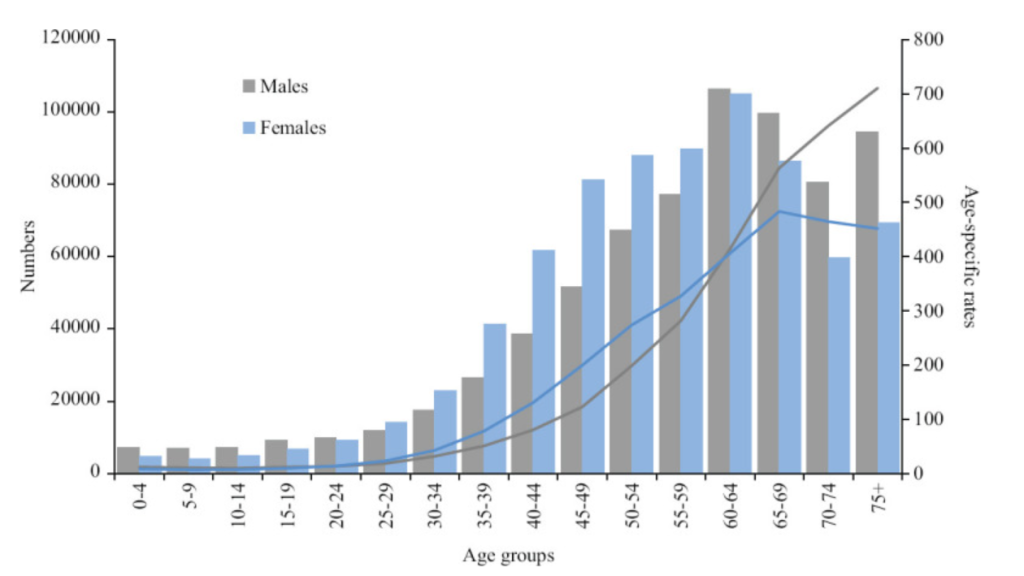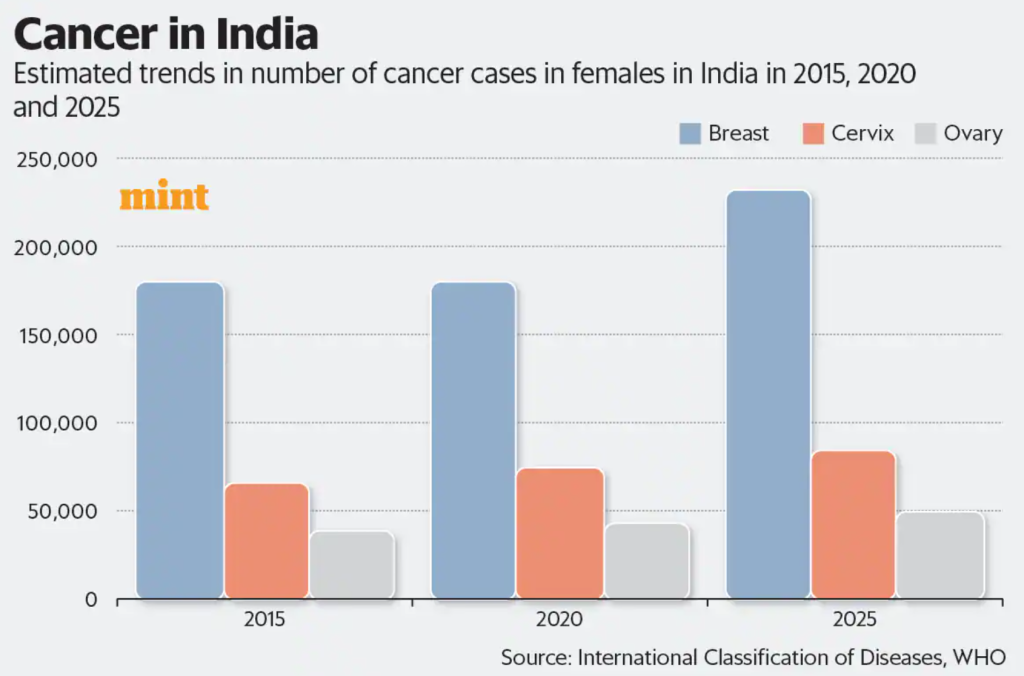CONTENTS
- Confronting Cancer: Are We Winning the War Against It?
- An Ambitious Push for Values, Ethics in Higher Education
Confronting Cancer: Are We Winning The War Against It?
Context:
Cancer, often labeled as the “emperor of maladies,” remains a significant obstacle for global medical researchers and scientists. Despite notable progress in medicine and biomedical science, cancer persists as an unyielding foe, with its impact rapidly intensifying in India. Immediate action is crucial to fortify cancer care infrastructure, enhance early detection, and improve preventive measures.
Relevance:
GS-2
- Health
- Government Policies & Interventions
Mains Question:
How can early detection, cost-effective treatment and preventive measures help India in dealing with the rising burden of cancer cases? Analyse the effectiveness of government’s initiatives taken in this regard. (15 Marks, 250 Words).
About Cancer:
- Cancer encompasses a broad category of diseases that can impact any part of the body, characterized by uncontrolled cell division.
- It is a severe condition, leading to numerous deaths annually from cancerous tumors.
- The initiation of cancer occurs when disruptions in the normal genetic processes lead to uncontrolled cell growth.
- This unregulated growth may result in the formation of a mass known as a tumor. Tumors can be classified as either cancerous (malignant) or non-cancerous (benign).
- Malignant tumors have the capability to grow and extend to other areas of the body, while benign tumors can grow but do not have the capacity to spread. Certain forms of cancer, such as leukemias, many lymphomas, and myeloma, do not manifest as tumors.
- In 2020, cancer emerged as a major global cause of death, contributing to almost 10 million fatalities, representing nearly one-sixth of all deaths.
- Prominent types include breast, lung, colon and rectum, and prostate cancers.
- Approximately one-third of cancer-related deaths stem from factors such as tobacco use, high body mass index, alcohol consumption, insufficient intake of fruits and vegetables, and a lack of physical activity.
- In low- and lower-middle-income countries, cancer-causing infections like human papillomavirus (HPV) and hepatitis are accountable for around 30% of cancer cases. Timely detection and effective treatment significantly contribute to the potential cure of many cancers.
Cancer in India:
- The recent report presented in Parliament emphasizes the unprecedented levels of the cancer burden in the country. In 2022, there was a notable increase, with 14.61 lakh cancer cases identified, marking a rise of 35,000 cases from the previous year. The mortality rate is even more distressing, with 8.08 lakh patients succumbing to cancer in 2022, compared to 7.89 lakh in 2021.
- Projections indicate a staggering 29.8 million cancer patients in India by 2025, portraying a somber outlook that should be a cause for concern among healthcare authorities and the general public.
- A 2022 study by the Federation of Indian Chambers of Commerce and Industry and Ernst & Young (FICCI-EY) suggests that the actual incidence of cancer in India may be significantly higher than official figures, underscoring the urgent need to address this issue promptly.
Challenges in Combating Cancer:
- Despite advancements in cancer treatment, the incidence of cancer and mortality rates persistently rise in India.
- The nation faces numerous challenges in effectively combating cancer, with prevalent types including breast, lung, colon, rectum, and prostate cancer.

- India also exhibits one of the highest mortality-to-incidence ratios for cancer globally, emphasizing the need for early detection and accessible treatment facilities.
- One of the primary contributors to the cancer crisis in India is the limited access to specialized hospitals with experienced oncologists and state-of-the-art machinery. Timely detection and affordable treatment are critical factors requiring immediate attention.
- Beyond well-known risk factors such as tobacco and alcohol consumption, obesity, and sedentary lifestyles, environmental factors also play a significant role in the rising disease burden.
Way Forward:
- It is imperative for the government to prioritize the establishment of cancer institutes and tertiary care centers to address the escalating demand for high-quality cancer care.
- While the public healthcare system is under strain, private hospitals often offer treatments that are financially inaccessible for many patients.
- Therefore, there is a need to enhance public awareness regarding cancer detection and prevention to effectively address this crisis.
- Encouraging healthy habits, such as regular exercise, plays a crucial role in mitigating the risk of cancer.
- Breast and cervical cancers are the primary causes of cancer-related mortality among women of reproductive age, but they are largely preventable through early screening and timely interventions.

- Public health campaigns that promote regular screenings and educate women about the significance of early detection can save numerous lives.
- As the burden of cancer increases, health authorities must prioritize early detection, affordable treatment, and preventive measures.
- Establishing specialized hospitals, combined with intensified public awareness campaigns, can significantly alleviate the challenges posed by cancer.
Conclusion:
The time for action is now, and India must unite in its collective effort to combat the formidable challenge posed by cancer. Only through collaborative endeavors can we hope to reverse the trajectory and provide a more promising future for cancer patients.
An Ambitious Push for Values, Ethics in Higher Education
Context:
The University Grants Commission (UGC) has been rapidly issuing regulations, guidelines, and directives, and some crucial ones have gone unnoticed by the higher education community. One such guideline is Mulya Pravah 2.0, a modified version of the previously notified Mulya Pravah in 2019. This guideline aims to instill human values and professional ethics in higher education institutions.
Relevance:
GS-2
- Government Policies and Interventions
- Education
GS-4
Role of Family Society and Educational Institutions in Inculcating Values
Mains Question:
Elaborating on the recently introduced Mulya Pravah 2.0 guidelines, analyse their effectiveness in instilling human values and professional ethics in higher education institutions. (10 Marks, 150 Words).
Mulya Pravah 2.0:
- Mulya Pravah 2.0 intends to create value-based institutions by aligning individuals and institutions with a profound respect for fundamental duties, constitutional values, and a strong connection with the country.
- The impetus for this initiative arises from a survey of human resource managers revealing unethical practices in various organizations.
- These practices include “favouritism in hiring, training, pay, and promotion; sexual harassment; gender discrimination in promotion; inconsistent views on discipline; lack of confidentiality; gender differentiation in compensation; non-performance factors overlooked in appraisals; arrangements with vendors for personal gain, and gender discrimination during recruitment and hiring.”
Analysis of Mulya Pravah 2.0:
| Provision | Analysis |
| Emphasis On Transparency: Mulya Pravah 2.0 underscores the importance of absolute transparency in administration, emphasizing that decision-making within higher education institutions should be guided solely by institutional and public interest, devoid of biases. It aims to eliminate discriminatory privileges of officials and urges the administration to take punitive measures against corruption. The guideline mandates higher education administration to conduct affairs with accountability, transparency, fairness, honesty, and the highest ethical standards. Furthermore, it asserts that officers and staff must abstain from misappropriating financial and other resources and should refuse to accept gifts, favors, services, or other items that may impact the impartial performance of their duties from any individual, group, private business, or public agency. | The guideline places significant importance on the encouragement of individuals at all levels to freely express their thoughts and advice. This provision is commendable and timely, given the diminishing prominence of these values. Authorities and officers of universities must ensure strict adherence to the provisions of their acts, statutes, ordinances, and regulations in both letter and spirit. It reminds them to act in the best interest of their institution, fostering a conducive culture and work environment for teaching, learning, and research while developing the potential of the institution. |
| Provisions Related to Confidentiality: Mulya Pravah places emphasis on the necessity and significance of maintaining information confidentiality. | This provision appears puzzling as it contradicts the right to information as a tool for ensuring accountability. Instead, higher education institutions should be mandated to proactively disclose all crucial information and willingly subject themselves to public scrutiny. |
| Teachers to Act as Role Models: While asserting that teaching is a noble profession and teachers play a vital role in shaping students’ character, personality, and careers, the guideline calls for teachers to act as role models, setting examples of good conduct and maintaining a high standard of dress, speech, and behavior worth emulating by students. | While this provision urges teachers to adhere to the provisions of acts, statutes, ordinances, rules, policies, and procedures of their universities but remains silent on the issue of teachers’ associations. |
| Unions and Support: Mulya Pravah 2.0 anticipates that staff and student unions will “support the administration in development activities and raise issues in a dignified manner.” Associations and unions of stakeholders serve as pressure groups to collectively influence and safeguard the rights and interests of their members. Higher education institutions constitute communities of scholars where no one stakeholder should hold more prominence than another. Each stakeholder should actively participate in preserving, protecting, and promoting the culture and standards of their institutions. The concept of collegiality should compel the administration to engage and consult with stakeholders in decision-making. | However, this seems to imply that they should act as a secondary team to the administration and refrain from raising concerns regarding their members. While it is not suggested that they should always be in conflict with the administration, it might be unrealistic to expect them to consistently align with the administration. Mulya Pravah 2.0 insists that staff and student unions must “raise issues in a dignified manner.” Since the guideline does not explicitly define what constitutes a “dignified manner,” this provision could be misused to intimidate, silence, or undermine the collective voices of stakeholders. There is a real and immediate threat, as associations and unions of teachers, staff, and students have often faced bans and suspensions on minor pretexts. |
Conclusion:
It is challenging for any institution to claim absolute freedom from malpractices. The UGC deserves acknowledgment for notifying this guideline, although its implementation may not be sufficient to eliminate corruption and uphold ethics and integrity. For Mulya Pravah to have a meaningful impact, sincere efforts are required to ensure its provisions are implemented in both word and spirit. The higher education regulator(s) should demonstrate zero tolerance and swiftly address even the smallest hint of corruption in admission, examination, hiring processes, or any aspect of university administration.




